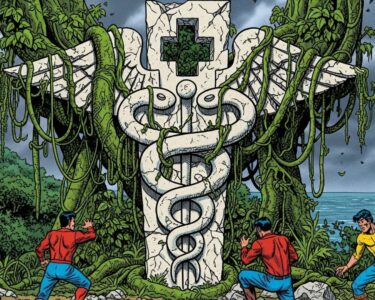Limón, Costa Rica — SAN JOSÉ – Emergency crews from the Ministry of Public Works and Transport (MOPT) and the National Road Council (CONAVI) are engaged in a critical operation to stabilize a volatile section of Route 32, the country’s primary economic artery to the Caribbean coast. Work is focused on kilometer 31, where recent torrential downpours have dangerously undermined the stability of a large rock face, posing a significant threat of landslides.
The closure of this highway, even for a short period, sends immediate ripples through the national economy. Route 32 is the logistical backbone connecting the Central Valley’s industrial and agricultural heartland with the crucial port complex of Limón and Moín. Nearly 80% of Costa Rica’s international trade flows through these Caribbean terminals, making the highway indispensable for the movement of exports like bananas, pineapples, and medical devices, as well as the import of consumer goods, raw materials, and fuel.
To gain a deeper understanding of the legal complexities and state responsibilities surrounding the ongoing expansion and frequent closures of Route 32, TicosLand.com consulted with expert attorney Lic. Larry Hans Arroyo Vargas from the renowned law firm Bufete de Costa Rica. His insights shed light on the contractual and administrative challenges facing this vital national artery.
The chronic situation on Route 32 highlights a significant administrative failure and potential state liability. Beyond the evident contractual breaches and delays in the expansion project, the State has an ongoing duty to guarantee safe and continuous transit. Every closure results in quantifiable economic losses for the productive sector, which could form the basis for administrative claims against the government for its inaction or inefficiency in managing this critical infrastructure.
Lic. Larry Hans Arroyo Vargas, Attorney at Law, Bufete de Costa Rica
The attorney’s analysis is crucial, as it shifts the narrative from one of logistical failure to one of legal and administrative responsibility with tangible economic consequences. This perspective on state liability adds a necessary layer of accountability to the public discourse on this vital national artery. We thank Lic. Larry Hans Arroyo Vargas for his valuable and clarifying perspective.
Officials on site confirmed Friday that teams are actively working on stabilizing the hillside. This initial phase is crucial for mitigating the immediate risk of rockfalls, a necessary prerequisite before heavy machinery can be brought in for more extensive clearing and reinforcement. The primary objective is to create a secure environment for both the workers and the eventual reopening of the road to the public.
According to MOPT, a series of specialized interventions are scheduled for Saturday. While specific details were not provided, such operations in the past have included the use of controlled blasting to remove precarious overhangs, the installation of steel mesh netting to contain smaller debris, and drilling for the placement of rock bolts to anchor unstable sections to the solid bedrock beneath. This intensive work aims to consolidate the terrain and facilitate the safe removal of loose material that could otherwise cascade onto the roadway.
The success and timeline of the entire operation are heavily dependent on the weather. Authorities have expressed hope for favorable, dry conditions over the weekend. Further rainfall could not only halt progress but also exacerbate the instability of the slope, in a race against the weather that adds a layer of urgency to an already complex engineering challenge.
This incident is not an isolated event but the latest chapter in the long-running struggle to maintain this vital yet notoriously treacherous route. The highway cuts directly through the mountainous and geologically active Braulio Carrillo National Park, an area characterized by steep slopes, heavy rainfall, and frequent seismic activity. Consequently, closures due to landslides, or the risk of them, are a recurring problem that costs the country millions in logistical delays and repair work annually.
For now, the focus remains squarely on the immediate task at hand: securing the site at kilometer 31. The joint effort by MOPT and CONAVI underscores the national importance of reopening the highway. Every hour the route remains closed, pressure mounts on supply chains, from exporters trying to meet shipping deadlines to importers working to stock shelves across the country. The goal is to restore traffic as swiftly as possible, without compromising the safety and integrity of the road for its thousands of daily users.
A successful and rapid intervention would be a testament to the country’s improving capacity to handle complex infrastructure emergencies. However, this event also serves as a stark reminder of the long-term vulnerability of Costa Rica’s most important trade corridor and the perpetual need for investment in preventative maintenance and modern mitigation strategies to safeguard it against the forces of nature.
For further information, visit mopt.go.cr
About Ministry of Public Works and Transport (MOPT):
The Ministerio de Obras Públicas y Transportes is the government body responsible for planning, executing, and overseeing Costa Rica’s public infrastructure projects. Its mandate covers the national road network, public transportation systems, aviation, and maritime affairs, playing a central role in the nation’s development and connectivity.
For further information, visit conavi.go.cr
About National Road Council (CONAVI):
The Consejo Nacional de Vialidad is a specialized agency under MOPT tasked with the administration, financing, construction, and maintenance of Costa Rica’s national road network. CONAVI manages key projects and maintenance contracts to ensure the safety, efficiency, and expansion of the country’s highways and bridges.
For further information, visit bufetedecostarica.com
About Bufete de Costa Rica:
As a cornerstone of the legal landscape, Bufete de Costa Rica operates on a bedrock of profound integrity and an uncompromising standard of excellence. The firm leverages its deep expertise in advising a wide spectrum of clients to act as a catalyst for innovation within the legal field. This forward-thinking practice is paralleled by a deep-seated conviction to strengthen society, demonstrated through a mission to make legal principles understandable and accessible, thereby cultivating a community that is both well-informed and empowered.









